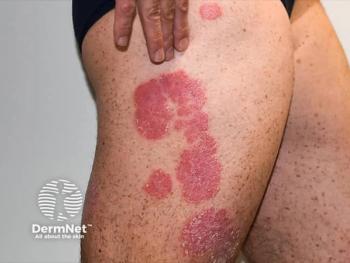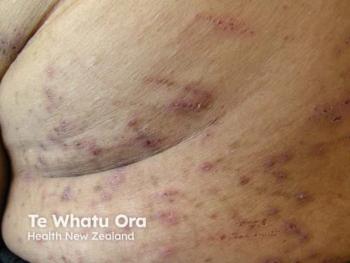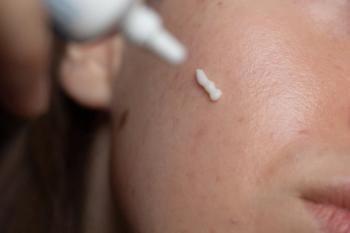
Upadacitinib Shows Promise in Reducing Cardiovascular and Thrombotic Risks in Atopic Dermatitis Patients
Key Takeaways
- Upadacitinib may reduce MACE and VTE risks in moderate to severe AD patients compared to background rates.
- The review utilized data from long-term safety studies and observational cohorts to assess cardiovascular and thrombotic event rates.
Researchers reported that upadacitinib may lower the incidence of major cardiovascular events and venous thromboembolism in AD.
A recent review published in the Journal of Drugs in Dermatology explored the potential cardioprotective and thromboprotective effects in upadacitinib, a selective JAK1 inhibitor, in patients with moderate to severe atopic dermatitis (AD).1
While upadacitinib is primarily known for its efficacy in controlling skin inflammation,2 the review suggests it may also play a role in reducing the risk of major adverse cardiovascular events (MACE) and venous thromboembolism (VTE).
Background and Methods
The review stems from the well-established link between chronic inflammatory skin conditions, such as AD, and increased cardiovascular and thrombotic risks.3 Existing literature indicates that systemic inflammation plays a key role in promoting atherosclerosis and hypercoagulability, leading to heightened incidences of myocardial infarction, stroke, and blood clots among these patients.4
In conducting this review, researchers performed a comprehensive search across PubMed, SCOPUS, and EMBASE databases for studies published up to early 2025. They filtered for observational and cohort studies that explicitly reported rates of MACE and VTE in populations with moderate to severe AD. The analysis focused on data from clinical trials involving upadacitinib, specifically, long-term (up to 5 years) safety data from pivotal clinical studies, Measure Up 1 and 2,5 and the AD Up extension trials.
The review also incorporated background incidence rates of MACE and VTE from existing observational data in AD patient cohorts, which served as reference points for assessing the potential impact of upadacitinib therapy.
Findings
The findings highlighted notable differences in cardiovascular and thrombotic event rates between AD populations and upadacitinib-treated patients. Background rates of MACE in patients with AD ranged from approximately 0.3 to 1.2 per 100 patient-years, with the highest rates observed in US and Danish cohorts.
In contrast, patients receiving upadacitinib therapy demonstrated significantly lower occurrences of MACE, with incidence rates of around 0.2 or less per 100 patient-years, with some data points showing rates below 0.1.
Similarly, the incidence of VTE among patients with AD typically hovered around 0.1 to 0.3 per 100 patient-years, but upadacitinib treatment was associated with even lower VTE rates, consistently at 0.1 across different doses.
These results suggest that upadacitinib not only effectively manages AD's skin symptoms but could also offer systemic protective effects against cardiovascular and thrombotic events. The authors emphasize, however, that these observations are hypothesis-generating and warrant further investigation.
Conclusions
The observed lower incidence rates of MACE and VTE in UPA-treated individuals compared to background populations could have meaningful implications for systemic disease management and long-term health outcomes.
However, limitations include the relatively short duration of the available long-term data and the absence of randomized controlled trials explicitly designed to assess cardiovascular safety. As the study authors note, these findings should be interpreted cautiously, and more comprehensive research, including prospective trials, are necessary to confirm the cardioprotective effects of upadacitinib and understand its mechanistic basis within systemic inflammation pathways.
Moving forward, the research team recommends continued investigation into the systemic benefits of JAK1 inhibitors, particularly their potential role in reducing cardiovascular and thrombotic risks in inflammatory skin diseases.
References
- Is upadacitinib cardioprotective in chronic inflammatory diseases? A review of major adverse cardiovascular events and venous thromboembolism in atopic dermatitis. J Drugs Dermatol. 2025;24(5):530.
doi:10.36849/JDD.9049 - Zhao DJ, Li X, Lin HX, Zheng H, Zhou D, Tang P. Efficacy and safety of upadacitinib in the treatment of moderate-to-severe atopic dermatitis: A systematic review. PLoS One. 2024;19(7):e0306463. Published 2024 Jul 26.
doi:10.1371/journal.pone.0306463 - Ingrassia JP, Maqsood MH, Gelfand JM, et al. Cardiovascular and venous thromboembolic risk with JAK inhibitors in immune-mediated inflammatory skin diseases: A systematic review and meta-analysis. JAMA Dermatol. 2024;160(1):28-36.
doi:10.1001/jamadermatol.2023.4090 - Henein MY, Vancheri S, Longo G, Vancheri F. The role of inflammation in cardiovascular disease. Int J Mol Sci. 2022;23(21):12906. Published 2022 Oct 26.
doi:10.3390/ijms232112906 - Guttman-Yassky E, Teixeira HD, Simpson EL, et al. Once-daily upadacitinib versus placebo in adolescents and adults with moderate-to-severe atopic dermatitis (Measure Up 1 and Measure Up 2): results from two replicate double-blind, randomised controlled phase 3 trials. Lancet. 2021;397(10290):2151–2168.
doi:10.1016/S0140-6736(21)00588-2
Newsletter
Like what you’re reading? Subscribe to Dermatology Times for weekly updates on therapies, innovations, and real-world practice tips.


















